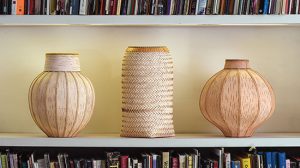
Dona Look
10dl #10-1, white birch bark and waxed silk thread, sewn with wrapped edge
12.6” x 10” x 10”, 2010
10dl #13-2, woven white birch bark, sewn and wrapped with waxed silk thread
13.75” x 8.5” x 8.5”, 2013
9dl #15-2, white birch bark and waxed silk thread sewn exterior, woven interior and wrapped edge
11.75” x 11.75” x 11.75”, 2015.
Photo by Tom Grotta
Each week of the year at browngrotta.com, we draw attention to a work, a book or a project by one of the artists we represent. Beginning this December, we’ll be providing a monthly round up of these works here on arttextstyle.com. This month on browngrotta.com we featured four very disparate works. First, baskets of white birch by Dona Look, who harvests the bark herself in Wisconsin where she lives. “Look carefully selects bark from large, healthy trees that will soon be logged—evaluating the diameter of each tree and the bark’s thickness, for its unique markings and flexibility,” explains Jane Milosch in “The Entanglement of Nature and Man,” Green from the Get Go: Contemporary International Basketmakers (browngrotta arts, Wilton, CT 2016). “Collecting and preparing the bark is painstaking and must be done in the spring when the sap is running. Unfortunately, her work has become increasingly difficult of late as not all of the trees are in a natural cycle, and some are dying due to climate change, such as white birch trees, once prevalent in northern Wisconsin forests.” The simple geometric patterns of some of her works, writes Milosch, “recall the patterns of Native American parfleche pouches, which were a kind of geographical depictions of the surrounding land, at the same time her basket preserves the radiant splendor of birch.”
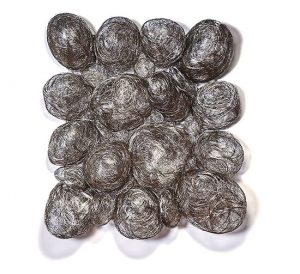
31kk Kyoko Kumai, Sen Man Na Yu Ta, stainless steel filaments, 44″ x 38″ x 7.75″, 2016. Photo by Tom Grotta
A strikingly different sensibility is evident in Sen Man Na Yu Ta, Kyoko Kumai’s wall sculpture of stainless steel. The steel filaments, mass-produced in a factory, are inorganic and monotonous by themselves, but when they are woven, twisted or bundled together they take on an organic appearance that serves to express various aspects of wind, air and light.
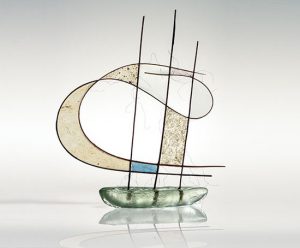
32jb Glass Boat, Jane Balsgaard, plantpaper, twigs and glass, 14″ x 13″ x 1.5″ 2015. Photo by Tom Grotta
Our third choice, Jane Balsgaard’s Glass Boat, deftly blends a sail of lightly processed handmade paper and a hull of glossy glass. Finally, in Process Piece, Ed Rossbach takes on construction, deconstruction and reconstruction in one work. First, he printed an image onto fabric, then he unraveled the fabric and finally re-constructed it into a new version. “I thought he was crazy,” his wife, artist Katherine Westphal told us.
The four works create a fine sentiment for 2017: Seek the splendid, airy, shiny and light; be willing to re-envision and remake.

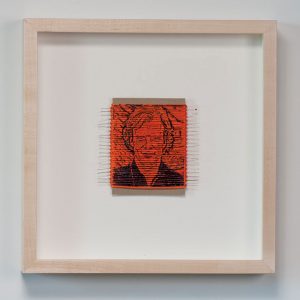
Books Make Great Gifts 2016
Another year of widely divergent books. Art, biology, history and biography are all represented in the answers we received to the questions we asked of artists that work with browngrotta arts: What books cheered you? Inspired you? Provided an escape?
Dona Anderson, wrote that she is reading Herbert Hoover: A Life by Glen Jeansonne (NAL, New York, 2016) who calls Hoover the most resourceful American since Benjamin Franklin. “I recently had a birthday and remember that my mother went to vote on the day I was born, November 6th, and she voted for Herbert Hoover. Consequently, I started to think about what the political atmosphere was like then — as ours was so crazy and even more so now. When I went to the library in October, the Hoover book was brand new and it appealed to me.”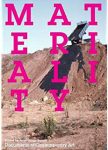 Rachel Max is reading Materiality, edited by Petra Lange-Berndt (MIT Press, Cambridge, 2015), one of the latest additons to the Whitechapel Documents of Contemporary Art series. It’s a fantastic series. Each volume in the series focuses on a specific theme and contains many thought-provoking essays from theorists and artists. Materiality not only addresses key geographical, social and philosophical issues, but it also examines how artists process and use materials in order to expand notions of time, space and participation. As the publisher notes, “this anthology focuses on the moments when materials become willful actors and agents within artistic processes.” Max has also been dipping into the diaries of Eva Hesse. “They are extremely private and were never meant for publication. But, as a huge fan of her work it is interesting to read her thoughts,” Max writes.
Rachel Max is reading Materiality, edited by Petra Lange-Berndt (MIT Press, Cambridge, 2015), one of the latest additons to the Whitechapel Documents of Contemporary Art series. It’s a fantastic series. Each volume in the series focuses on a specific theme and contains many thought-provoking essays from theorists and artists. Materiality not only addresses key geographical, social and philosophical issues, but it also examines how artists process and use materials in order to expand notions of time, space and participation. As the publisher notes, “this anthology focuses on the moments when materials become willful actors and agents within artistic processes.” Max has also been dipping into the diaries of Eva Hesse. “They are extremely private and were never meant for publication. But, as a huge fan of her work it is interesting to read her thoughts,” Max writes.
Nimura’s skillful crafting of a can’t-put-it-down narrative of their experiences on two sides of the Pacific is a vividly rich visual, as well as historical, account. She produced for the reader, through captivating descriptions illuminating the startling differences between these two very different cultures, the contrasting worlds we could easily visualize.
Stacy Shiff, Pulitzer Prise-winning author of Cleopatra wrote: “Nimura reconstructs their Alice-in-Wonderland adventure: the girls are so exotic as to qualify as ‘princesses’ on their American arrival. One feels “enormous” on her return to Japan.” It is just this Alice-in-Wonderland aspect of their story that caught my imagination. As in Louis Carroll’s Alice’s Adventures in Wonderland, it is the environment and the material culture that sets the stage for remarkable events. The tangible aspects of two vastly contrasting cultures – intellectually, technically, behaviorally and in terms of the accoutrements of every day life, express well the often conflicting, peculiar and unexpected events in the girls’ lives. The girls move from Japanese clothing, furniture and customs to western style and then back again feeling more comfortable in western settings than in their birth homes kneeling on the floor and lavishly swathed in yards and yards of embroidered silks.
In the late 19th century the US was bursting with inventions and change. Planning begun in the 1850s for the Chicago World’s Fair was well under way, ushering in the Gilded Age of rapid industrial growth, design innovation and expansion of popular culture. A startlingly appropriate time for the girls’ cultural experiment to take place. Nimura, who moved to Japan for three years with her Japanese/American nesei husband, was adept at utilizing her keen sense of design and broad knowledge of the two disparate material cultures. She skillfully brought to life the vast differences between the two civilizations through masterful and insightful descriptions of clothing, hairstyles, furniture, interiors, architecture as well as the cities in which they existed. This, combined with her extensive research, presents the reader with many insights into the relations between the two countries and their intertwined histories through the lives of these exceptional girls and their extraordinary adventures.
As Miriam Kingsberg of the Los Angeles Review of Books wrote, “Daughters… is, perhaps, less a story of Japanese out of place in their country, than of women ahead of their time.” Laky adds that while she was a professor of art and design at the University of California, Davis, she encouraged her students to study abroad. “This book illustrates how education and experience in a foreign country enhances understanding of other cultures and peoples – perhaps more important today than in the 1870s and 80s. I believe travel also greatly inspires creativity.”
It is a sad and exciting story about a typical lonely man in today’s Denmark, she wrote. “Written in a wonderful language – so one can just imagine him, by reading it and it is just as sad as Stoner.
As always, enjoy!